
February 2022 — Defining a downtown or business district’s trade area is an important first step in any market analysis. This step is crucial because it defines approximate boundaries that will serve as the basis for further study. It also helps individual businesses identify opportunities to expand their own trade area.
In today’s business environment, traffic is complex with online sales and mobile shoppers. In this context, a general community trade area that represents a majority of local residents attracted to a business district is a good place to focus. No community has a single trade area. In reality, each individual business has its own trade area. However, for this purpose, you must define a general trade area to represent the community and to adequately do a community-wide analysis.
In community economic development, a trade area is a geographic area from which a community generates the majority of its customers. Sometimes a community may have more than one trade area (such as a convenience and a destination trade area). Knowing the size and shape of each trade area is extremely important because its boundaries allow for the measurement of the number of potential customers, their demographics, and their spending potential. This information provides valuable insight into your community’s customer base and allows you to calculate demand for stores, products, and services.
Other geographic areas often used include:
- 10 – Minute Walk-Time – representing the area close to downtown where many residents can walk to retail, services and social gatherings.
- Study Area – the core downtown area often defined by a Business Improvement District and often representing the highest commercial and/or residential area in the community.
This section includes information on how to define your trade area(s). You will be able to apply these methods to define the most appropriate geographical boundaries using zip codes, political boundaries or U.S. Census designations.
Factors that Influence Trade Areas
Trade areas often extend beyond city or neighborhood boundaries and come in a variety of shapes and sizes, depending on a community’s pulling power (such as the supply of businesses and nearby competition) and local geography (see the example trade area map below). A business district may serve a number of different trade areas depending on a variety of factors such as types of products sold or customer market segments served.
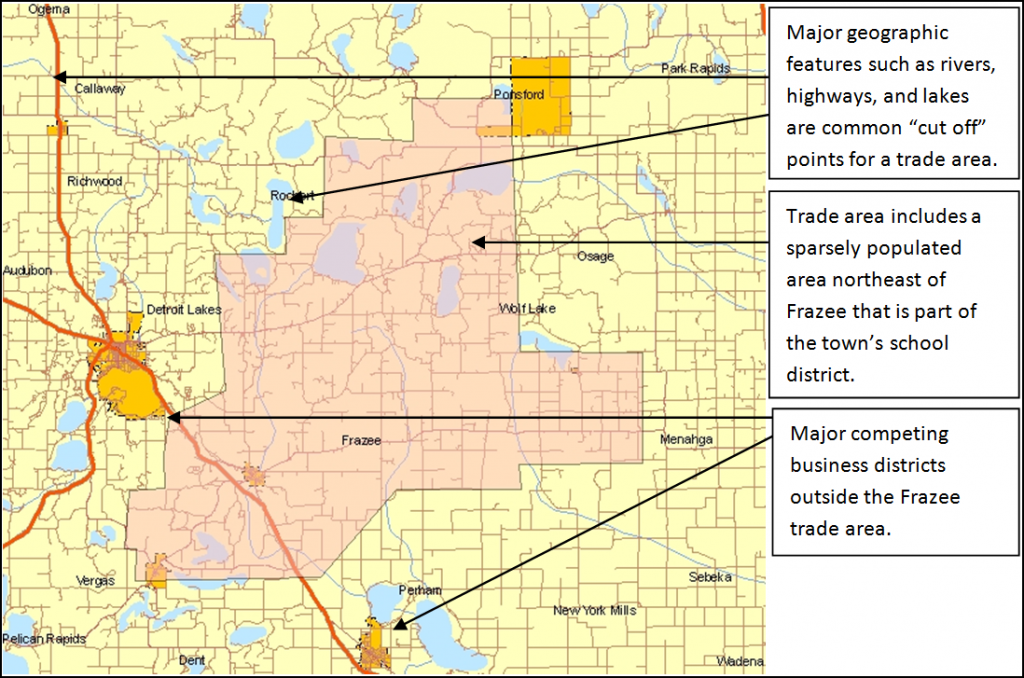
Important Factors
Various factors determine trade area(s) including the community’s population and its proximity to other competing business districts (see Reilly’s Law below). These factors include:
- Population of your community: Generally the larger your community’s population, the bigger your trade area is.
- Proximity of other competing business districts: Typically there is a cutoff point where customers are drawn to the competing center instead of your community.
- Mix of businesses in your community: A critical mass of businesses pulls customers from a further distance than a more limited mix of businesses.
- Attractions: A destination business (such as a large discount department store) or community attraction such as a prominent employer can expand your trade area—drawing customers from a long distance.
- Traffic patterns: Each region has distinct traffic patterns strongly impacted by its network of streets and highways, as well as major landforms such as rivers, lakes, and mountains.
Reilly's Law of Retail Gravitation
Reilly’s Law of Retail Gravitation is a theoretical means of defining a trade area. It is based on the premise that people are attracted to larger communities to do their shopping, but the time and distance they must travel influence their willingness to shop in a given city. In other words, people are more likely to travel shorter distances when possible. Additionally, customers are more likely to shop in larger communities as they typically offer more goods and services.

Consider the map of Waupaca, Wisconsin. The map shows the location of Waupaca along with surrounding communities. The populations of each of these towns and cities are provided below the community name. Based on community populations and their distribution, you can draw a simple trade area (shown by the red line) using the concepts of Reilly’s Law.
For instance, residents of Amherst or Nelsonville live closer to Stevens Point than Waupaca. Furthermore, the Stevens Point area is larger in population. Therefore people living in these communities will more likely travel to Stevens Point than Waupaca. In contrast, residents of Ogdensburg are closer to Waupaca and will most likely shop accordingly. From such observations, you can estimate the entire trade area.
While theoretical, using Reilly’s Law provides a general sense of the community’s trade area as a whole. This method requires little effort and few resources. However, Reilly’s Law does not capture possible variations in the trade area. Additionally, Reilly’s Law is less appropriate if you are defining both convenience and destination shopping trade areas. There are ways to overcome these deficiencies, however, including one based on actual customer data discussed later in this section.
Types of Trade Areas
Trade areas fall under two major categories: convenience trade areas and destination trade areas. Most small communities encompass only one type of trade area (primary trade area). However, communities with over 10,000 residents may find it useful to define both a convenience and a destination trade area.
- A convenience trade area is based on the purchase of products and services needed on a regular basis, such as gasoline, groceries, and hair care. Because these purchases are relatively frequent, people usually find it more convenient to buy these products and services from businesses located close to their home or workplace. A grocery store’s trade area can often be used to represent a community’s convenience trade area.
- A destination trade area is based on the purchase of “major” products and services, such as appliances or furniture, or of products and services that are distinctive in such a way, such as deeply discounted products and services. People are willing to travel longer distances to do comparison shopping and purchase these kinds of items. A large discount department store’s trade area can often be used to represent a community’s destination trade area.
In addition to differing by types of goods and services, a business district differs in the types of customers who shop there. Three common market segments are:
1. Local residents within the trade area. As they reside locally year-round, they provide the majority of spending potential for most businesses.
2. Daytime employees who may live in the trade area or others who commute from other communities. They have the potential to make purchases within the trade area during the workday.
3. Tourists and second-homeowners can offer a large amount of spending potential. While they are not permanent residents, tourists obviously shop while visiting the area. Analysis of the geographic origin of non-resident customers is discussed in the appendix of this section.
Defining Trade Areas Using Focus Groups
Defining trade areas is sometimes more of an art than a science and no one method is always correct. Whatever method you choose to define a trade area (including convenience and destination trade areas), make sure the area you ultimately delineate represents the entire business district or community. If a trade area is too small or too large, your demographic and spending calculations based on that area will be unrealistic and of questionable value. Focus groups help you ensure that your trade area will be broadly representative. Two methods for defining trade areas using focus groups are described below.
Business Owners Focus Group Approach
Experienced business owners typically know their customers well. Asking a group of business owners or operators to undertake a focus group mapping exercise is an efficient way to define your trade area.
Steps for Conducting Business Owners Focus Group Trade Area Exercise
- Hand out printed maps of the general region with a couple of rings drawn on the map (typically 5- and 10- mile radii) to give a sense of distance.
- Explain to participants that a local trade area is an area in which a majority of the local customers live (often defined as the area where 75 percent live). Communities can have a significant number of customers who are seasonal customers, tourists, or other visitors, but the focus here is on local residents.
- Explain that individual businesses have their own trade area. A destination business like a furniture store typically has a larger trade area than a convenience business like a gas station or grocery store. For this exercise, participants must not think in terms of their individual business, but rather in terms of the entire business community. Another way of framing the idea of a community trade area is to ask participants to visualize various trade areas of individual businesses layered on the same map and try to draw a “typical” trade area for convenience businesses and one for destination businesses.
- Have individual participants shade on the map where they think the convenience and destination trade areas lie. Again, small communities may have one trade area.
- Bring the group to a consensus about the trade area(s) for the overall business district. Consider using a map displayed on a computer projector for discussion and shade in this master copy as you elicit feedback from the group. Start by gaining agreement on a core area and work for consensus, working around the core area to define the extent of the trade area in each direction (north, south, east, and west). Ask questions like “At what point would a customer choose to travel to community A rather than your community?”
- Some potential pitfalls of the mapping exercise approach are the potential for one or two strong-willed participants to dominate the exercise and the tendency for community merchants to inflate their trade area(s). The primary counter to these issues is to emphasize that the purpose of the exercise is to define a reasonable trade area(s) for the entire business district (not one or two merchants).
The following map illustrates the development of a single trade area for the rural community of Barnesville, Minnesota. Maps provided to focus groups typically include major roads, zip code boundaries, distances from the center of the community, and nearby community names. These elements are included in the map to give enough geographic context so participants can make an informed decision. This is an example of how participants used some of the map elements, such as a 10-mile ring or highway network, to determine the best fitting zip code trade area.
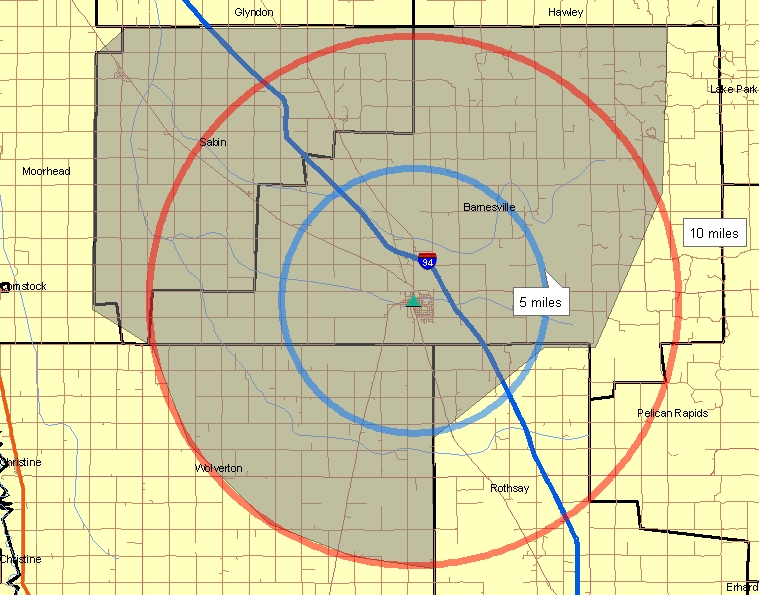
Consumer Focus Group Approach
Since communities in a region compete with one another for customers, one approach is to ask consumers to define your trade area in relation to regional competition. To do so, you can ask a focus group of consumers from your community about their shopping patterns within the region. The process of finding the relative preferences of competing trade areas will help you understand the flow of retails dollars in and out of your community. The following example worksheet can help you determine competing centers, trade areas (convenience and destination), and regional shopping patterns.

The worksheet reflects a range of goods so the entire region can be mapped (see the Evaluating Retail and Service Business Opportunities section for more information on retail goods and their hierarchy). We also suggest the facilitator bring a map of the region to orient focus group members. The facilitator also should instruct focus group participants to think not only about their own shopping habits but also about where other people living in your community are likely to shop for these items. Based on participants’ answers to questions, the facilitator can gain a better sense of shopping patterns within and outside of the community.
Steps for Conducting a Consumer Focus Group Trade Area Exercise
- Assemble a focus group of consumers who reside in your community.
- Explain to participants that the purpose of the exercise is to identify the overall region in which they do a majority of their shopping and to determine the convenience and destination trade areas of your business district. Display a map for their orientation.
- Explain that the worksheet includes a range of goods from convenience goods, such as gasoline, to destination goods, such as furniture. Instruct them to fill out the worksheet based on their own shopping habits, as well as what they believe are the predominant shopping habits of others in your community.
- Give participants some time to complete the worksheet on their own before moving to a group discussion where participants can compare their answers.
- Compile the feedback from the group to define both a convenience and destination trade area for your community. For each type of trade area:
1. Identify major retail centers in the region that compete with your downtown.
2. Draw a line delineating a trade area around each of the competing retail centers. (See the example map below.) Remember that larger commercial centers (in sales or number of establishments) typically have larger trade areas.
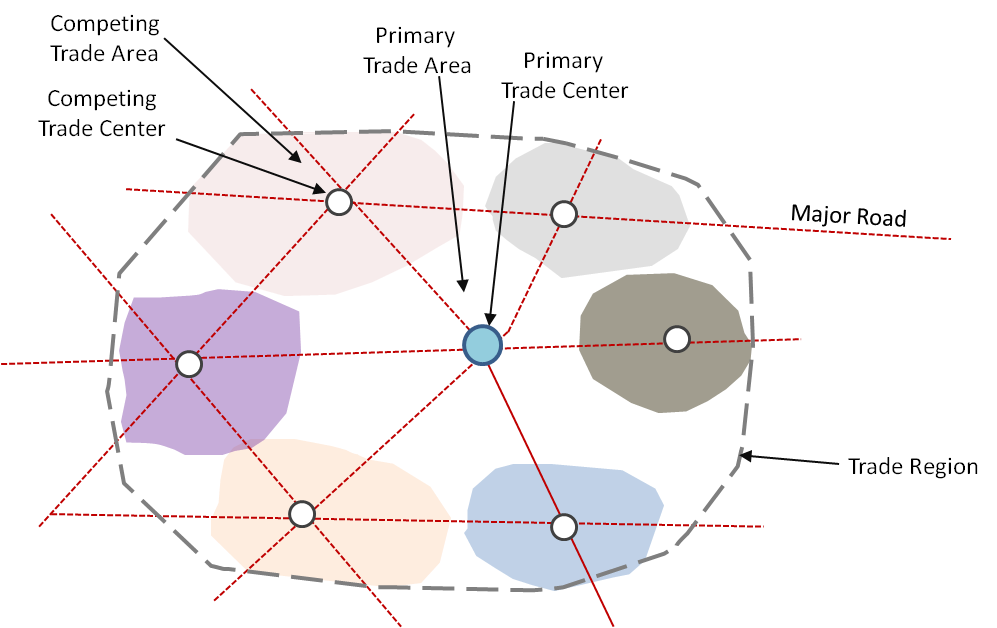
Defining Trade Areas using Standard Geography
A trade area defines where customers live and how far they are likely to travel to a particular business or business district. Thus, basic map data, such as distances, highways, and physical barriers, can be useful in defining trade areas. What’s more, using Geographic Information System (GIS) software for trade area analysis offers a number of advantages over hand-generated mapping techniques.
Geographic Information System (GIS)
GIS software matches a variety of data to specific geographic locations and displays the results on maps rather than in tables or charts. GIS enables you to easily combine a variety of data from several different sources and formats to create maps that help illustrate important trends in the data. GIS also aids in the recognition of important market trends that would often go unnoticed without the ability to visualize the data on a map.
While many users of this toolbox may not have their own desktop-based GIS software, advances in web-based applications are making these mapping techniques more accessible. Further, there are many consultants, city planners and marketing data providers who can offer technical or analytical assistance in using GIS software.
Following are descriptions of five GIS techniques using basic geographic data: simple rings, data-driven rings, drive-time polygons, equal competition areas, and gravity modeling. Many of these techniques were drawn from documentation supporting ESRI’s ArcGIS Business Analyst GIS software.
Simple Rings
Maps with distance rings (i.e. 1, 2, and 3-mile rings) are the simplest and most widely used method for defining a trade area. While they can be drawn from any point, the middle of a downtown is often the most appropriate point from which to create distance rings. See the following example map:
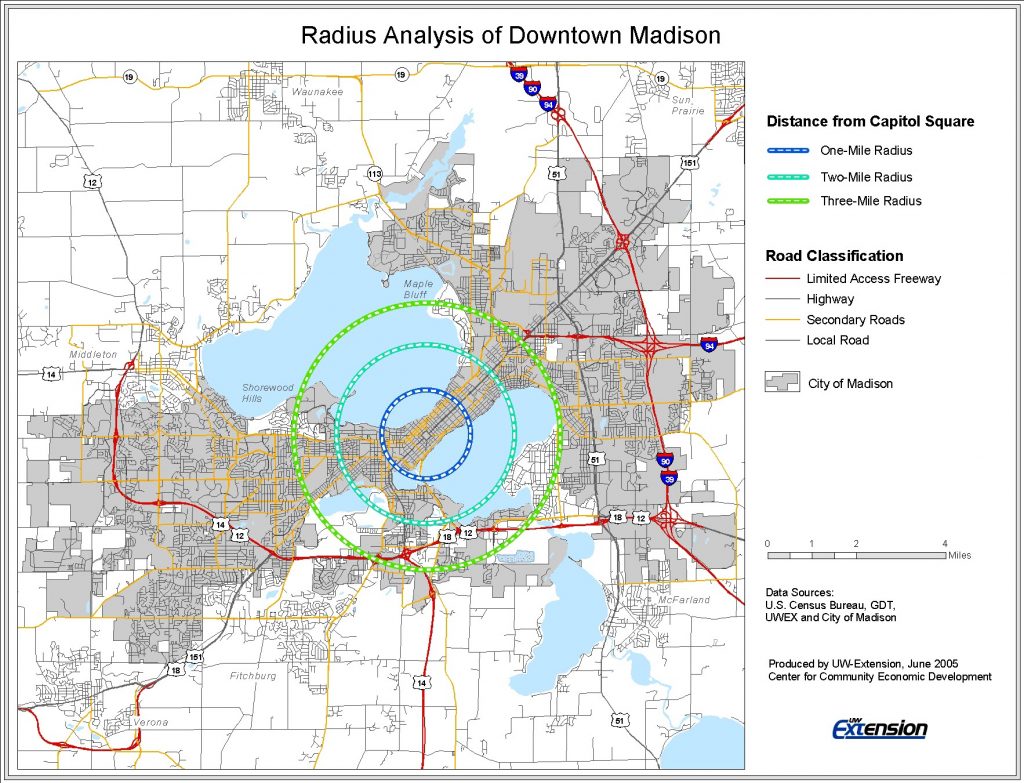
This approach can work for a quick analysis or for communities that are located in fairly uniform geography. For example, if you are defining a trade area for a small community surrounded by similarly-sized communities that are all spaced 20 miles from one another, a simple ring of 10 miles may be a reasonable trade area for analysis.
While rings are an easy method to use, they fail to recognize travel barriers, such as natural features (mountains, rivers, lakes, etc.) and man-made elements (road networks, etc.). Subsequently, rings are useful for only simple analysis. This weakness is demonstrated in the previous example map.
Data-Driven Rings
Data-driven rings are based on business district values—such as volume of sales, store size, or number of stores—rather than distance, as are simple rings. Data-driven rings can be used to define trade areas by adjusting the size of the ring by one of the business district values. The greater the data value, the larger the ring—which affects the size of your trade area. You can use this method to compare your business district with others in the region. See the following example map:
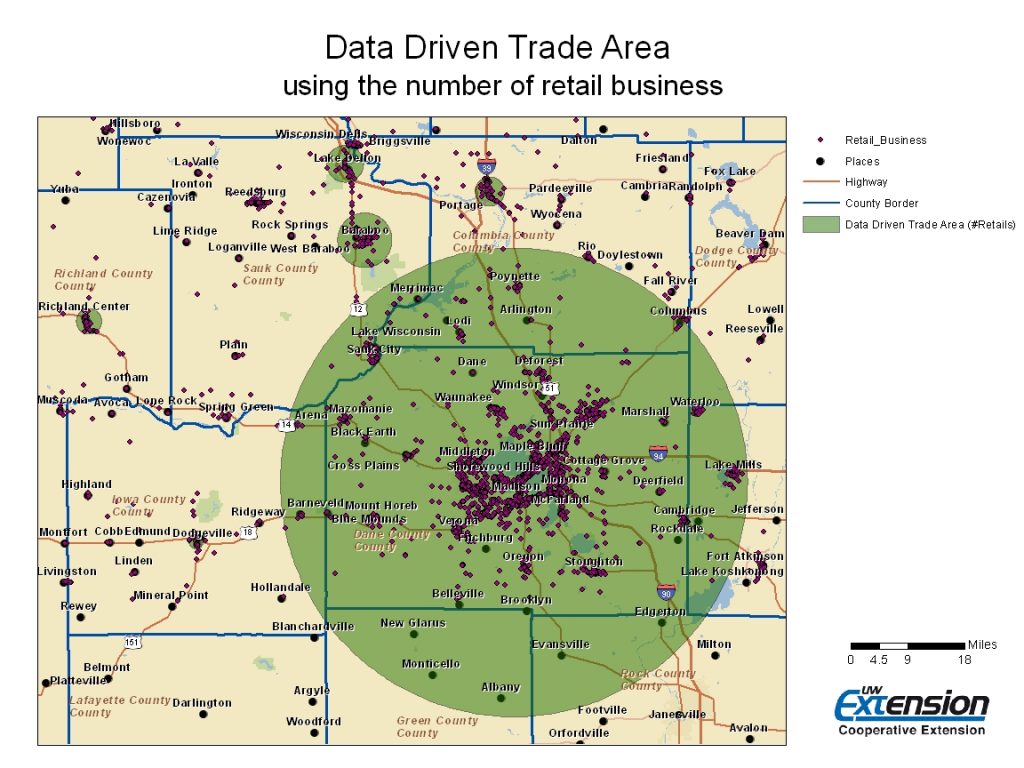
However, while data-driven rings are useful in comparing competitive business districts, they may not have a direct relationship with a trade area defined by customer origin (see Defining Trade Areas Using Actual Customer Data below). Further, data such as retail sales or store size may be difficult to obtain.
Drive-Time Polygons
Maps that illustrate drive times to your business district provide a useful method for determining trade areas based on travel time and road networks. These maps use distances along actual streets and highways, combined with their respective travel speeds, to calculate travel time. Drive time polygons (a GIS term for an area) are important as consumers make decisions based on streets and highways when deciding where they will shop.
The following map illustrates a drive time analysis used to calculate 5-, 10-, and 15 -minute travel times into downtown Madison, Wisconsin. The map also displays the geographic distribution of other shopping destinations surrounding downtown Madison.

Equal Competition Areas (Thiessen polygons)
Another type of trade area is called an equal competition area (also known as Thiessen polygons in honor of Alfred Thiessen, a meteorologist who pioneered the method of creating areas out of spatially distributed data). This type of trade area assumes that consumers will travel to the closest business district in their region based on “as-the-crow-flies” distances. The trade area is formed by lines drawn exactly halfway between each of the competing business districts. Any point within the equal competition area is closer to the subject business district than any of the surrounding business districts. See the following map which illustrates this method.
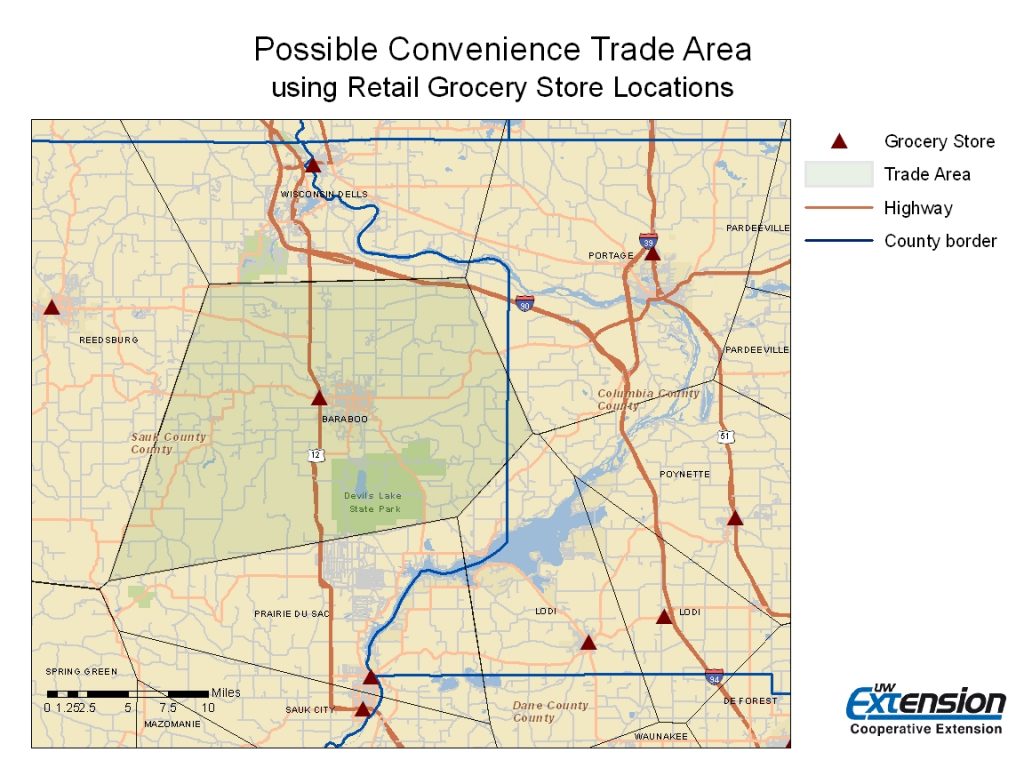
Since equal competition areas are based on as-the-crow-flies distances, these trade areas do not adjust for the way people actually travel on the ground. Further, they do not adjust for the drawing power of each competing business districts. Accordingly, it is helpful to use equal competition area maps along with drive time and other maps.
Gravity Modeling
Gravity modeling provides an additional method for examining competition and potential shopping patterns around a business district. In simple terms, a gravity model attempts to predict the probability that a customer will shop at a given commercial center. The model accounts for the distribution and attractiveness of competing business districts, along with distance a customer will have to travel to each district. For this analysis, estimates of retail sales for existing retail concentrations can be used as a proxy for a business district’s attractiveness.
The example map of gravity modeling shows the results of a downtown Milwaukee gravity analysis. Specifically, the map shows the probability (i.e. percent chance) that a consumer living in a given area will choose downtown Milwaukee over another competing business district. As one would expect, residents living in areas closest to downtown Milwaukee have the highest probability of shopping downtown.
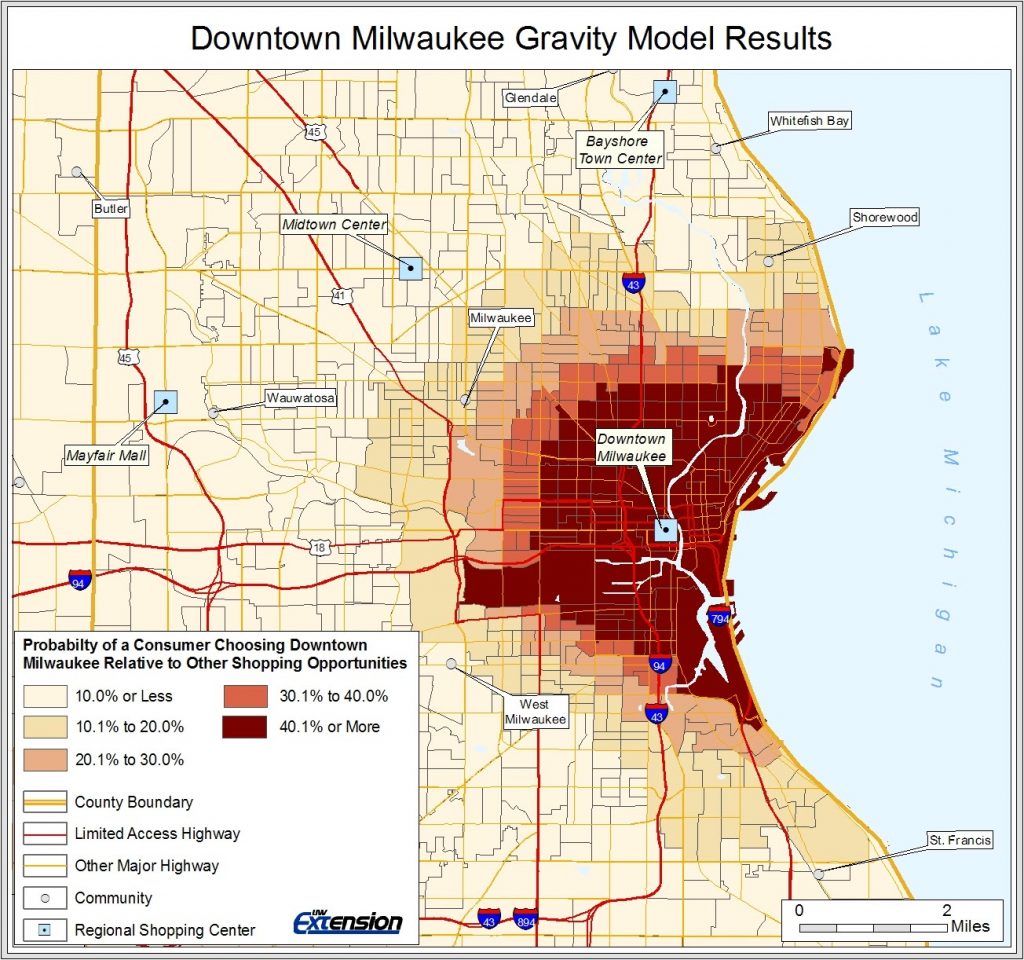
Defining Trade Areas using Actual Customer Data
Trade areas based on actual customer data have a number of distinct advantages. Combining actual customer addresses or zip codes with GIS allows you to uncover relationships and perform calculations unavailable with tabular data. A GIS can visually display where customers are coming from, show how customer concentrations are related over an area and perform advanced distance-based calculations. See Defining Trade Areas using Geographic Data.
You can collect address or zip code data using a variety of methods and sources. However, regardless of how the data is obtained, this method offers a number of advantages, including:
- Collecting information from customers allows the trade area to be based on real business data, instead of created from estimates.
- Comparing the trade area maps of different businesses can identify opportunities to increase market size and penetration. For instance, the trade areas for businesses that primarily sell convenience items can be compared with each other to identify variation. These differences could indicate potential market expansion opportunities for some of the businesses. The same can be done for comparison shopping businesses.
- Trade areas for different market segments can be compared. Businesses serving residents can be compared to the origins (or home address) of employees at a major employer. Furthermore, addresses or zip codes are ideal for tracking the origins of tourists.
While using customer addresses or zip codes to analyze a trade area has the ability to capture trade area variability, an appropriate sample of customer lists from participating businesses must be incorporated. For instance, stores that serve both convenience and destination shopping segments are necessary to understand the local market. Businesses that serve tourists must be incorporated into your analysis to examine the tourist market segment. Employee lists from major employers are necessary to explore the daytime population market segment.
Trade Area Based on Customer Street Addresses
Ideally, customer origins are defined by a street address. While zip codes can be used, knowing the street address will allow for a more accurate trade area definition. Using the street address and a process known as geocoding, GIS software can map the origin of each customer. After mapping each address, another GIS technique can be used to define rings based on the percentage of overall customers. These rings, or customer penetration polygons, can be drawn according to different customer percentages. Furthermore, these customer penetration polygons help account for the store trade area in the context of demographics, travel barriers and other market characteristics.
As an example, a GIS could draw a customer penetration polygon based on a pre-determined customer percentage (e.g. 75 percent). This polygon could then be used as the trade area boundary for a business. Using actual data, the example map of Customer Origins by Street Address below shows a trade area definition example based on customer addresses. The map shows customer origins for a store in Milwaukee with sample customer penetration polygons of 25, 50 and 75 percent.
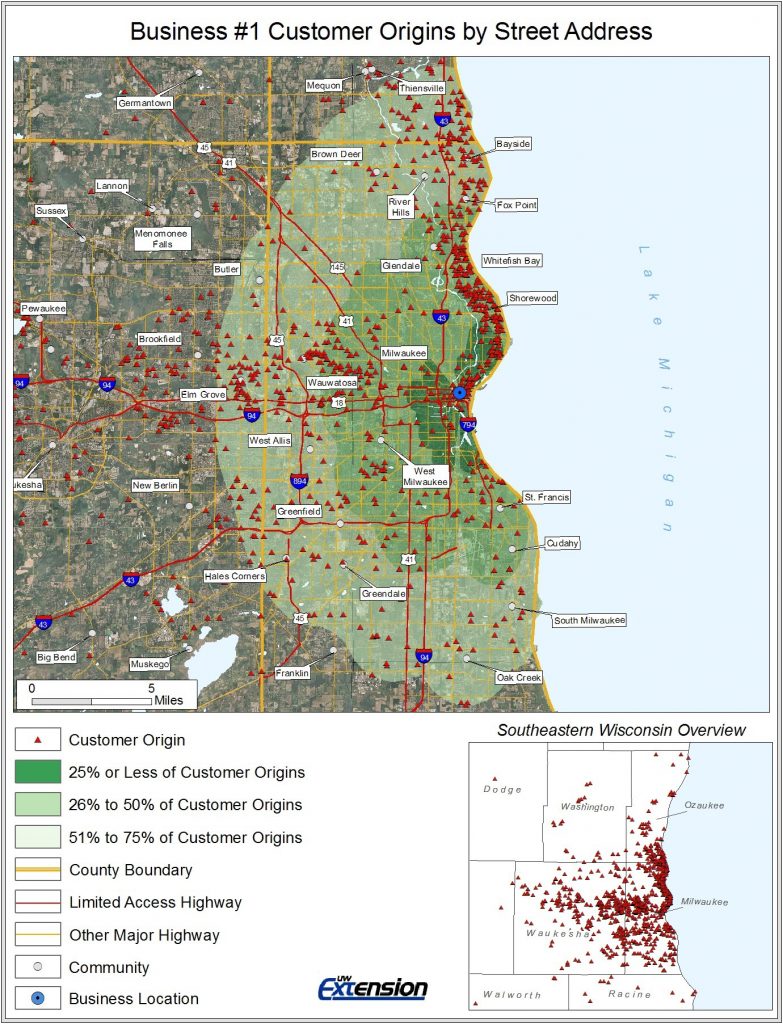
Trade Area Based on Customer Zip Codes
While customer street addresses are advantageous, zip codes are a viable alternative. Although not as precise in pinpointing customer origins as street addresses, zip codes are easier to collect and work well in rural areas where geocoding accuracy often diminishes. You can categorize customer zip codes by the percentage of customers (patronizing a business district) originating from each zip code. These percentages can then be mapped to show the relative origins of customers.
Doing so allows you to examine relationships among customers (areas of high and low percentage, directional nature of customers, contiguous vs. fractured origin patterns, etc.) The example of customer origins by zip code map below shows an example of a trade area defined for Tomah, Wisconsin. Notice how the customer origins are biased toward the east due to proximity to a major highway and the presence of the similar-sized community, Sparta, to the west. These are the types of relationships that would not be readily apparent in a table of customer zip codes.
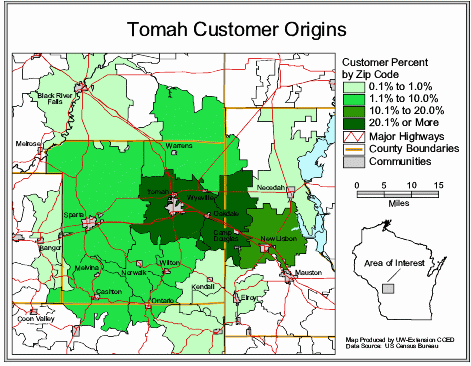
As noted, you can collect customer zip codes in a variety of ways. Some businesses, such as hotels and grocery stores already collect this information for their daily operations. Often, zip code collection can be built into point-of-sale machines (cash registers). A customer’s zip code can be entered in a cash register and then downloaded into a ready-to-use spreadsheet program, such as Microsoft Excel. If this method is unavailable, a trade area definition data collection sheet, such as the one in the exhibit below, can be used to record zip codes by hand. As clerks check out customers, they can enter their zip codes on the sheet. While it is more labor intensive, the trade area definition sheet also offers the ability to recorded additional information with the zip code (such as date, time, gender, age range, and amount of sale).
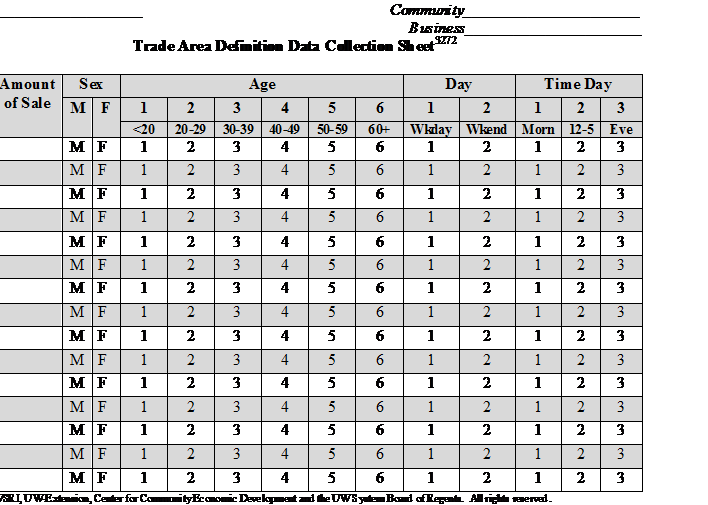
Once zip codes have been collected, they can be entered into a spreadsheet program such as Microsoft Excel. The spreadsheet allows categorizing customers by the number and percentage of people originating in each zip code. The zip code percentages can then be grouped together to construct a trade area. Most often, the trade area is defined as those with zip codes that comprise about 75 percent of total customers. If you are creating both convenience and destination trade areas, you will need to create two separate tables.
Trade Areas Representing Non-Local Customers
Generally, local residents provide a majority of sales in a community since most shop in town (or in the region) year-round. However, some communities have important customer segments that do not live locally, such as day-time employees, seasonal residents, and tourists. Because these customers live some distance away, the addition of “non-local customer” trade areas may be helpful if you want to include their demographics and spending potential in your analysis. We focus on tourists in this appendix, but techniques are useful for analyzing all types of non-local resident customers.
Tourist Clustering Analysis
Defining a trade area for tourists poses special challenges because tourist origins can be widely distributed and a single trade area does not fully represent where these customers are coming from. Instead, tourists can be clustered into multiple trade areas to better represent the geographic pockets where they are concentrated. See the following example map:
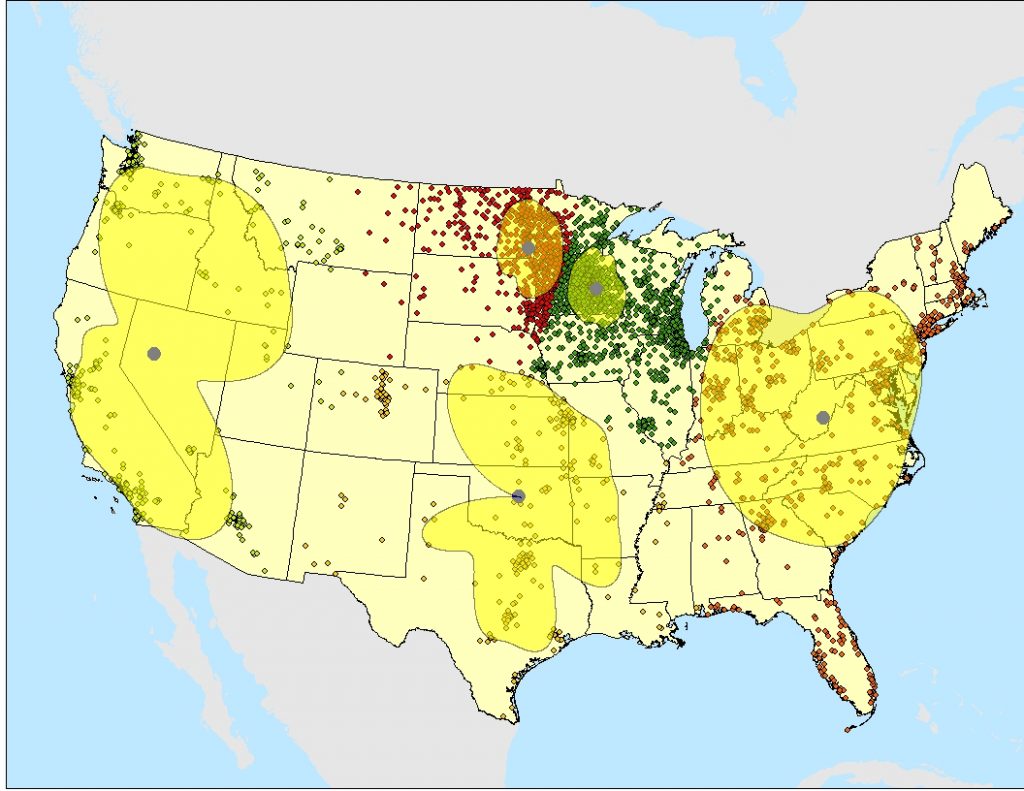
As noted, you can use a similar approach for discerning clusters for other non-local resident customers, such as in-commuters, seasonal residents, or any other segment whose spending affects your business district but live (year-round) outside your community.
Tourist Profiling and Prospecting
By mapping the origins of your tourists, you can also analyze the demographics of their home neighborhoods as a basis for attracting tourists from other neighborhoods with similar demographics. Here again, you can use GIS software with existing customer address lists to generate a profile or their origins and demographics of their neighborhoods. GIS then uses this information to search (prospect) for potential new customers.
Geographic Profiling
The profiling process begins by creating a spreadsheet with GIS software mapping customer addresses. The initial mapping process shows the distribution of every tourist customer’s home community and indicates where tourist customers are clustered. While the map provides a general view, GIS can also be used to calculate the numbers of tourists by geographic area and distances that generate the most customers. See the following example:
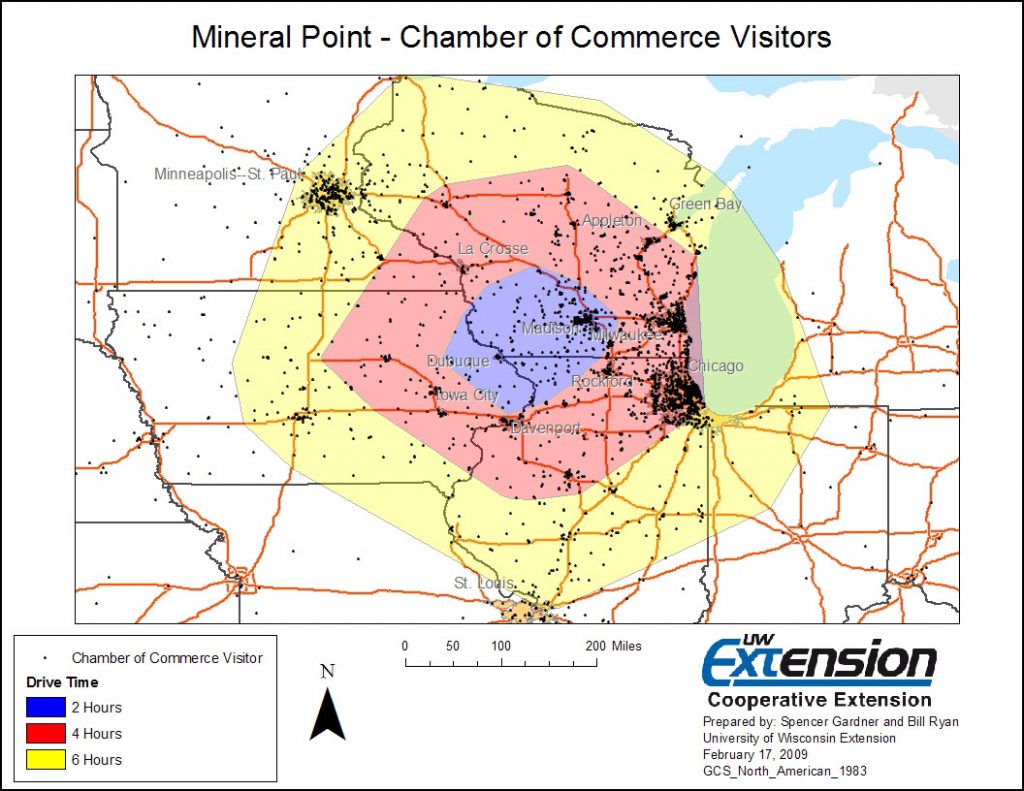
Typically, geographic profiling of tourists divides them by drive time and by geographic areas such as counties or metropolitan areas. These calculations provide insight into how far customers are willing to travel, as well as the areas that produce the most customers.
Demographic Profiling
In addition to identifying the geographic origin of tourist customers, GIS also provides their demographic composition. By knowing customer addresses, demographic information can be obtained about the neighborhoods where they live. This is because pre-defined neighborhoods, such as census block groups or zip codes, have robust demographic information associated with their boundaries. GIS can link neighborhood demographic information to each customer address. The combination generates a neighborhood demographic profile that describes all customers coming from that location. The profile can contain information such as visitors’ incomes, professions, marital status, ages, and education levels. Using customer segmentation data from private data firms, GIS profiling methods can also be used to describe tourist customers’ lifestyles and preferred leisure activities, as well as products they may purchase.
Prospecting for New Customers
GIS also can take the analysis a step further and identify geographic areas similar to those identified in the profiles where new tourist customers might come from. Depending on the scope of the analysis, a number of demographic categories can be used as the customer search criteria. GIS is used to search, or prospect, for neighborhoods that meet these demographic requirements. The neighborhoods that have been “prospected” can then be combined with the geographic profile to determine the best areas for new marketing efforts. See the following example map:

About the Toolbox and this Section
The 2022 update of the toolbox marks over two decades of change in our small city downtowns. It is designed to be a resource to help communities work with their Extension educator, consultant, or on their own to collect data, evaluate opportunities, and develop strategies to become a stronger economic and social center. It is a teaching tool to help build local capacity to make more informed decisions.
This free online resource has been developed and updated by over 100 university educators and graduate students from the University of Wisconsin – Madison, Division of Extension, the University of Minnesota Extension, the Ohio State University Extension, and Michigan State University – Extension. Other downtown and community development professionals have also contributed to its content.
The toolbox is aligned with the principles of the National Main Street Center. The Wisconsin Main Street Program was a key partner in the development of the initial release of the toolbox. One of the purposes of the toolbox has been to expand the examination of downtowns by involving university educators and researchers from a broad variety of perspectives.
The current contributors to each section are identified by name and email at the beginning of each section. For more information or to discuss a particular topic, contact us.

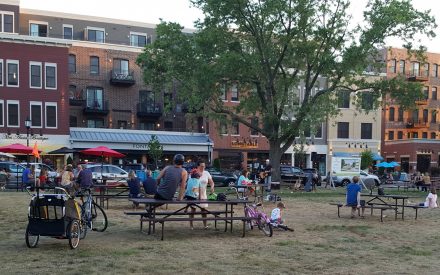



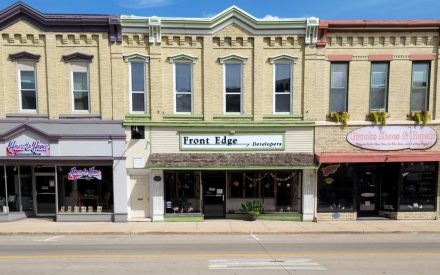

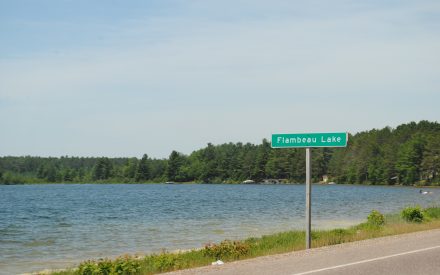


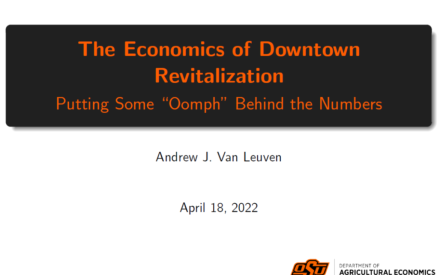

 How to Utilize Data for Community Economic Development (Part II)
How to Utilize Data for Community Economic Development (Part II) How to Access Data for Community Economic Development (Part I)
How to Access Data for Community Economic Development (Part I) Focus Group Analysis Tips
Focus Group Analysis Tips Developing Questions for Focus Group Interviews
Developing Questions for Focus Group Interviews


